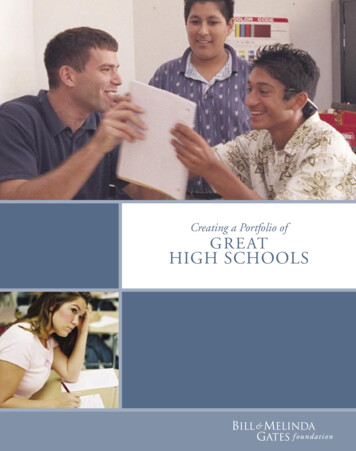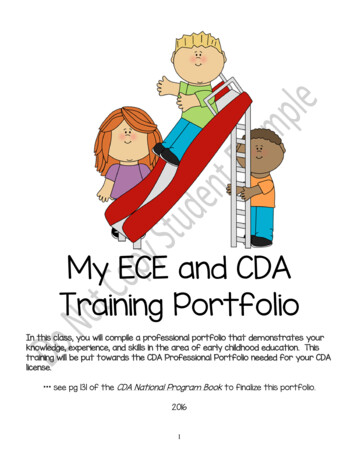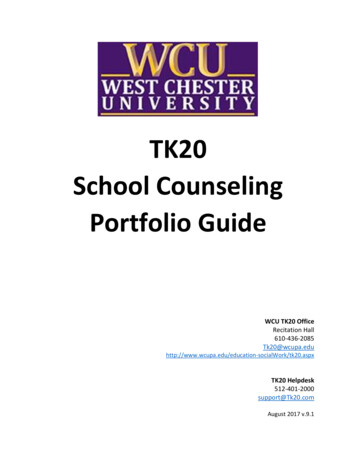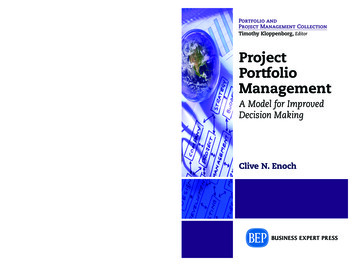
Transcription
Creating a Portfolio ofG R E ATHIGH SCHOOLS
America’s high schools aren’tmaking the grade. It’s time for a new approach.Most school systems feature one kindof high school: a large, comprehensiveschool with more than a thousandstudents and a course catalog as thickas a phone book. It’s the kind of schoolthat tries to be all things to all people.Unfortunately, many of these largeschools simply don’t work for most oftheir students.Consider these troubling statistics:About 30 percent of today’s eighthgraders will not graduate from highschool four years from now. Anotherthird will graduate, but without theskills they need to do well in college orhold a family-wage job.How did the American educationsystem come to this? The large schoolsthat many of these students attend weredesigned 50 years ago to educate youngpeople by perceived ability, preparingone third for the professions and onethird for the trades while letting thefinal third drop out sometime aftereighth grade. It didn’t make much sensethen, but today, it’s an economic andcivic disaster. No less than 80 percentof prison inmates are high schooldropouts.To reverse these disturbing trends,we must begin to picture a new highschool landscape—one where everystudent graduates ready for college.That will require a diverse set of smallschools that engage young people moreeffectively. After all, students learn indifferent ways; their schools shouldteach in different ways. In this newlandscape, schools may have differentemphases, teaching approaches, orphilosophies, but they will all prepareevery student for college. In a systemwith a diverse portfolio of schools, nosingle school will fit every student. Butevery student will fit at least one school.The high schools profiled in thisbrochure show the wide range ofschools that communities can create—schools that give every student the bestchance to succeed.3
What makes a great high school?High schools come in many shapes andsizes. They may emphasize differentsubjects, follow different educationalphilosophies, or build different schoolcultures. Within this variety, though, wehave found that all great high schoolshave three elements in common: They expect every student to graduateready for college or a family-wage job. They engage all students inchallenging course work that isrelevant to their lives and theiraspirations. They are likely to be small—mosteducating no more than 100 studentsper grade—so that students getpersonal attention in a safe, respectfulenvironment.There are perhaps hundreds of waysto create a mix of schools with thesethree elements, which can makecreating a diverse portfolio of schools abewildering task. What is the right mixfor your community?4It may help to group schools into oneof three general categories: traditional,theme-based, and student-centered.To some degree, these categories areartificial constructs—no actual schoolfits neatly into one category, and manyexcellent schools do not fit into anyof them. To the extent practical, eachcommunity should aim to have atleast one school from each of the threecategories as options for parents andstudents.The chart on the next page brieflydescribes the three types of schools. Tolearn more about each type, read theprofiles on the following pages.Three types of great high ardia Middle College – Early College High School,These schools teach traditional subjects, but focus on rigorously preparing New York, NY; Lionel Wilson College PreparatoryAcademy, Oakland, CA; Cristo Rey Jesuit High School,every student for college or work.Chicago, IL; Frederick Douglass Academy, Harlem, NYThemebasedThese schools organize courseworkaround a theme—such as the sciences,technology, or the arts—to engagestudents in a college-prep curriculum.High Tech High, San Diego, CA; Tacoma School ofthe Arts, Tacoma, WA; Zoo School, Minneapolis, MN;Boston Arts Academy, Boston, MA; ExpeditionaryLearning Schools; Francis W. Parker Charter EssentialSchool, Devon, MA; Fenway High School, Boston, MAStudentcenteredThese schools create individualizedplans for each student, often withstudents’ input, and may focusespecially on dropouts or at-risk youth.The Met, Providence, RI; Minnesota New CountrySchool, Henderson, MN; Maya Angelou Public CharterSchool, Washington, D.C.; Portland Community College,Portland, OR
TR A D I T I O N A L S C H O O L SThey only seem familiar.At first glance, the high schools inthis category may look familiar. Theyemphasize mastery of typical subjectmatter—mathematics, literature,science, history—and use traditionalapproaches to instruction. But thecomparisons end there. Exemplaryschools in this category are unrelentingin their efforts to ensure that all of theirstudents, especially those poor andminority students who are frequentlyleft behind in comprehensive highschools, are prepared for college. Theyadopt a “no excuses” attitude coupledwith a support structure that virtuallyprevents students from failing.LaGuardia Middle College –Early College High SchoolNew York City, NYLaGuardia integrates grades 9 through12 with what we might call grades13 and 14, forming a coherent andaccelerated course of study. Created bya partnership between the city’s boardof education and the City University ofNew York (CUNY) system, LaGuardiaseeks to foster academic success forthose students for whom college wouldbe considered out of reach. But witha steadfast belief in every student’spotential to succeed in high school andattend college, LaGuardia helps themmaster a challenging curriculum byusing a range of instructional practicesand support services—includingstudent internships, peer counseling,6individual and group projects, andtutoring.In their ninth- and tenth-grade years,students take high school courses.Beginning in the fall of their junioryear, they take college-level courses,including history, sociology, literature,and introduction to computers. Andthe students are succeeding: LaGuardiastudents are passing more of theircourses than their college counterparts.Exemplary schools in this categoryensure that all their students,especially poor and minoritystudents, are prepared for college.By the thirteenth year—a year aftermany students from their cohort willhave graduated from high school—students at LaGuardia enroll in collegecourses of their choosing to fulfill theremaining requirements for an associateof arts degree. Although students nolonger take high school courses, theschool continues to support them.While LaGuardia takes a traditionalacademic approach, there are excellentearly college high schools in everycategory. No matter how they aredesigned, all early college high schoolsrecognize the same basic fact: allstudents should go to college, but theywill all find different ways to get there.Lionel Wilson CollegePreparatory AcademyOakland, CAFounded in September 2002, LionelWilson Prep was Oakland’s first newhigh school in 40 years. It serves 420students in sixth through twelfth grade,nearly all of them minority studentsfrom low-income families. But itdoesn’t shy away from an academicallyrigorous, standards-focused program.Students study a standard curriculumthat develops five qualities in everystudent: personal responsibility, socialresponsibility, critical and creativethinking, application of knowledge,and communication.They are required to make publicpresentations in five areas, from mathand science to Spanish and history.At the center of the student supportsystem is a student advisor who workswith students and their familiesthroughout their time at Lionel WilsonPrep. Students meet with their advisorevery day, and twice a year they leada conference with their advisor andparents to discuss their goals and reflecton their progress. Lionel Wilson Prepboasts a 95 percent attendance rate.
TH E M E - B A S E D S C H O O L SThey spark students’ unique interests.Schools organized around a themetypically integrate that theme—forinstance, the arts, math and science, orcareer—into all aspects of a standardcollege-prep education. In addition tooffering theme-based courses (dancein a school for the arts, or artificialintelligence in a school focused onmath and science), teachers of the moretraditional subjects infuse their lessonswith examples from the theme.High Tech HighSan Diego, CAHigh Tech High was created in 2000to address the shortage of qualifiedhigh-technology workers in San Diegoand to create a rigorous educationalenvironment. Technology and preengineering are integrated throughoutthe curriculum. Teachers guidestudents through a project-basedapproach to learning: making a filmabout Gettysburg, holding a publicdebate on evolution, writing a businessplan for a biotech start-up. In theirjunior and senior years, students enterinternships with local businesses thatmatch their interests and skills, whichlinks schoolwork to the working world.The school’s open floor plan, highceilings, and low walls encouragethe 400 students and their teachersto interact freely. There are noclassrooms—only specialized labs—8and every student has access to aworkstation with an Internet-readycomputer. High Tech High sent 96percent of its graduates to college in2003, even though fewer than half hadcollege-educated parents.Tacoma School of the ArtsTacoma, WAThe curriculum at Tacoma School ofthe Arts (or SOTA) is centered on fineart as a means of engaging students,creating a powerful school structure,and providing focus for students andteachers. Students are drawn to theschool because they have in interestin the arts, but what they get is anacademically rigorous, college-prepcurriculum in a supportive atmosphere.Schools integrate the themeinto all aspects of a standardcollege-prep education.With a maximum of 350 students, theschool is small and built on communitypartnerships with established arts andcultural organizations. Students attend90-minute classes, and each year theyhave the opportunity to become deeplyimmersed in internships or a singlecourse of study. Classes meet in manylocations across Tacoma’s downtowncore: in renovated business spaces, incultural and arts facilities, and on auniversity’s satellite campus.In 2003 the school posted the state’shighest scores on the tenth grade statestandardized tests in reading and math,proving that students learn when theyare engaged in their subject matter.
STU D E N T- C E N T E R E D S C H OOLSThey give every studentintense personal attention.All good schools, large or small,are built around the needs of theirstudents. But some are even morefocused, providing an individualizededucation for each student. In theseschools, students frequently designtheir own course for learning with helpfrom a teacher. Indeed, some schoolseschew traditional administrators,leaving the management of the schoolto the teachers themselves.Other schools in this category seek toreengage students who have droppedout of high school or are at serious riskof doing so. These dropout recoveryschools typically keep class sizes verysmall (with as few as five students perteacher), work intensively with studentsto build basic skills, use a variety ofstudent assessments (presentations andjournals, for example, in addition tostandardized tests), allow or requirestudents to live on campus, and offera range of support services, includingcounseling, internships, job placement,mentoring, and lessons in moneymanagement.Minnesota New Country SchoolHenderson, MNLocal teachers formed MinnesotaNew Country School in 1994 withthe hopes of creating a collaborative,rigorous, nontraditional learning10environment. Other than a dailyreading period, there is no setcurriculum for the school. Teachershelp students complete independentand group projects during the schoolyear, ranging from boat building toresearch on the deformities of localfrogs. The school’s 120 students spendmost of their time in a single large,open room that includes student andteacher workstations. In addition,New Country has a science classroom,a greenhouse, a library room, and awoodworking and auto shop. Threequarters of the graduating class goto college, a significantly higherproportion than rural schools withcomparable student populations.Maya AngelouPublic Charter SchoolWashington, D.C.Part school and part youthdevelopment program, the MayaAngelou Public Charter School serves85 students, many of whom have beenthrough the juvenile justice system.They spend their first year studyingsocial issues—such as the waysin which people are shaped bycommunities, including their localtraditions, values, and expectations.Students conclude the term witha community history project thatintegrates interviews and oral histories,art, photography, and their ownwriting about the places in which theylive. In subsequent years, students turnto more traditional subjects, such asAmerican literature, geography, andmath. They also take at least two termsof technology and computer classes.Because many of the school’s studentsbenefit from a carefully structured day,they remain in the building until8 p.m. four days a week. Theseextended hours include dinner, oneon-one counseling, and 70-minutetutoring sessions in addition to classes.Intensive, one-on-one instructionhelps students who have droppedout of school or are at risk ofdropping out.The school year runs 11 months, andmany students live full-time in theschool’s dormitory. Each one worksfour to six hours per week at a payingjob during the academic term. Theyalso work part- or full-time periodicallythroughout the year. It is estimatedthat 50 to 70 percent of Maya AngelouPublic Charter School graduates goon to college, and the rest will movedirectly into the workplace.
What makes a successful school system?The categories of schools in thisbrochure are intended as a guideto leaders interested in developinga portfolio of high school options.There are many combinations of highschools that could meet the needs of acommunity. To be effective, however,districts should develop policies forsupporting these diverse schools thatinclude: Options with equity.Left completely unregulated, asystem of choice is likely to reflect,rather than reduce, economicinequities: the best schools willgravitate to the neighborhoods withthe most influence. Instead, leadersmust carefully plan their schools’Communication.Creating options for all students isbased on the premise that all studentsand parents have absolute access toinformation. For this approach towork effectively, school system andmunicipal leaders must work hardto reach out to those families whoare least likely to understand theiroptions.Quality assurance.School system and municipal leadersmust hold every high school in aportfolio accountable for meetingone goal: preparing all students forcollege, careers, and citizenship.When schools do not meet thisgoal, leaders must take appropriateaction—which starts with providingthe training and information schoolsneed to improve, and may ultimatelyend with an academic intervention. locations and curricula, target lowincome students appropriately, andcommunicate with all stakeholders. School formation.Systems must be able to develop newschools when the need or interestarises. New schools do not necessarilyrequire new buildings; there aremany examples of schools sharingspace with a community center orother organization or taking over anentire vacant building. Learning networks.No school should work in isolation.Through networks of schools,educators can share best practicesand help each other improve theirschools.13
Where to gofrom hereCreating a great portfolio of highschool options won’t happenovernight. So where should school andcommunity leaders begin?Visit great schools.You don’t have to start from scratch.Civic and education leaders alike canbenefit from seeing innovative solutionsfirsthand, brainstorming, and sharingresources with others who are achievingresults. They should travel outsidetheir districts and visit other greatschools that have developed innovativesolutions to common problems, suchas those profiled in this brochure. Andthey should encourage every memberof their community—parents, teachers,students, business leaders—to do thesame.Determine which typesof schools will work bestfor the community.Civic and education leaders, parents,students, and businesses should worktogether to decide which kinds ofschools they want.14A few questions to consider: What types of high school optionsdo students currently have? Do highincome students have better optionsthan low-income students? What do students and parents want? What do community members andlocal businesses need? Is there anunmet demand for workers withcertain skills? What resources and partners can thecommunity draw on?Start a new school.A few good schools here and thereare not enough. We need to provide10,000 great high schools in the next10 years to meet the needs of thiscountry’s children. Lead the drive tostart one in your community.For more information on newschool models and assistance onstarting new schools, visitwww.gatesfoundation.org/education.
The Bill & Melinda Gates Foundationworks to promote greater equity in fourareas: global health, education, publiclibraries, and support for at-risk familiesin Washington State and Oregon. TheSeattle-based foundation joins local,national, and international partners toensure that advances in these areas reachthose who need them most.P.O. Box 23350Seattle, WA 98102-0650U.S.A.V 206.709.3100F 206.709.3180www.gatesfoundation.org 2004 Bill & Melinda Gates Foundation. All rights reserved.
Lionel Wilson College Preparatory Academy Oakland, CA Founded in September 2002, Lionel Wilson Prep was Oakland's first new high school in 40 years. It serves 420 students in sixth through twelfth grade, nearly all of them minority students from low-income families. But it doesn't shy away from an academically rigorous, standards-focused .











